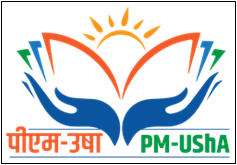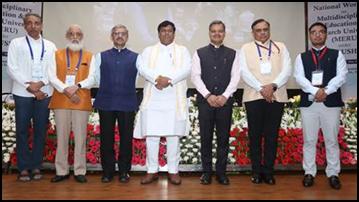Social Welfare
Pradhan Mantri Uchchatar Shiksha Abhiyan (PM-USHA)
Building Stronger Institutions for a Knowledge-Driven Future
Posted On:
02 MAY 2025 3:48PM
Introduction
The PM-USHA is a Centrally Sponsored Scheme launched by the Ministry of Education, Government of India, in June 2023. It aims to enhance the quality of higher education in State-run institutions by promoting accessibility, equity, accountability, affordability, and quality, aligning with the five pillars of the National Education Policy (NEP) 2020. As the demand for higher education is increasing continuously over the years, there has been an unprecedented expansion in the number of institutions, universities, and volume of students in the country.

Recently, a two-day National Workshop on Multi-Disciplinary Education and Research Universities (MERU) under Pradhan Mantri Uchchatar Shiksha Abhiyan (PM-USHA) was held on April 30, 2025 and May 1, 2025 at ICAR, New Delhi. The event saw the participation of over 64 Vice Chancellors from over 64 different universities, along with State officials represented by State Project Directors of Higher Education. The national workshop provided essential guidance on how best to implement various elements of the NEP in collaboration with central and state government funding. The Union Minister of State for Education and Development of the North Eastern Region announced that for 35 universities, the Ministry is providing Rs. 100 crore each for implementing 44 mandatory activities under the MERU components. Further, during this two-day seminar 12 important sessions were held on topics like UGC Regulations for NEP Implementation, Clustering and Collaboration for Multidisciplinary Education, Holistic Education through Integration of Skilling and Industry Connect, etc. Eminent academicians and officials participated in these speaker sessions.

Funding and Implementation
PM-USHA has an outlay of ₹12,926.10 crore for the period 2023-24 to 2025-26. A total of 33 States and Union Territories have signed the Memorandum of Understanding (MoU) for participating in the scheme. In the first and second meetings of the Project Approval Board for PM-USHA, 440 units have been approved in various States/UTs with a total amount of ₹5,613.12 crore under various components. For FY 2025-26, the budget for this scheme has been kept ₹1,815 crore.
PM-USHA is funded through the Ministry of Education (MoE) with prescribed contributions from the State governments and Union Territories (UTs). The project cost in the public-funded institutions for all sub-components is shared between the Central Government and State Governments in the ratio of 90:10 for North Eastern States, J&K, Himachal Pradesh, and Uttarakhand and 60:40 for the Other States and UTs with Legislature, the UTs without Legislature would be 100% centrally funded under this scheme.
The amount of Management Monitoring Evaluation and Research (MMER) grants is 2% of the total fund approved, out of which 1 % will be released to the States/ UTs and 1% will be utilized by the Centre. The fund will be utilized for activities related to the implementation and monitoring of the scheme by the States/ UTs and Centre such as operation of the technical support group, monitoring portal etc. All States/UTs will be eligible for these grants.

PM-USHA shall be implemented and monitored through an institutional structure of bodies with clearly defined roles and powers at the Central, State, and institutional levels. All the bodies shall monitor the progress of the scheme at their respective levels, starting right from the institutional level up to the national level.
Background
Rashtriya Uchchatar Shiksha Abhiyan (RUSA) was a Centrally Sponsored Scheme to fund States/UTs institutions, with the vision to attain higher levels of access, equity, and excellence in the State higher education system with greater efficiency, transparency, accountability, and responsiveness. The first phase of the scheme was launched in 2013 and the second phase was launched in 2018. Now, in the light of the National Education Policy, RUSA scheme has been launched as PM-USHA.
RUSA 1.0 and RUSA 2.0 have resulted in significant progress in a number of higher educational indicators like Gross Enrollment Ratio (GER), and Accreditation (Quality Reforms), Student-Teacher ratio, etc. However, the gap still remained vis-à-vis. access, inclusion, enrolment, quality enhancement, skilling, employability, technology, etc. and therefore, some new interventions were required for achieving the targets and reducing the gaps, ensuring better output and outcome.
PM-USHA addresses key gaps highlighted in the NITI Aayog's Evaluation Report by redesigning and rationalizing existing schemes for greater impact. It focuses on enhancing graduate employability through market-linked courses, industry collaboration, internships, and skill-based education. The scheme emphasizes tracking employability outcomes, identifying skill gaps, and introducing employment-led vocational modules. It promotes the use of technology and open distance learning to improve access and quality, supports institutions in improving National Assessment and Accreditation Council (NAAC) accreditation, and encourages quality initiatives, virtual learning, community participation, and gender sensitization, while closely monitoring outputs and outcomes. With the emergence of the NEP 2020 and recommendations of NITI Aayog, an effort has been made to give a new and energized structure to this phase of the scheme.
Objectives
The objectives of this scheme are:
To improve the overall quality of existing state higher educational institutions (HEIs) by ensuring their conformity to prescribed norms and standards and adoption of accreditation as a quality assurance framework.
Usher transformative reforms in the State higher education system by creating a facilitating institutional structure for planning and monitoring at the state level, promoting autonomy in State Universities, and improving governance in institutions.
Implementation of recommendations of the NEP 2020 through funding support provided to State HEIs.
Ensure governance, academic, and examination (and evaluation) reforms in the State higher educational institutions and establish backward and forward linkages with school education on one hand and employment market, on the other hand, to facilitate self-reliance and thus creating an Atmanirbhar Bharat.
Create an enabling atmosphere in the higher educational institutions to devote themselves to research and innovations.
Correct regional imbalances in access to higher education by facilitating access to high-quality institutions in urban & semi‐urban areas, creating opportunities for students from rural areas to get access to better quality institutions, and setting up institutions in unserved & underserved areas.
Developing infrastructure for ODL/Online/Digital mode of education in such States/UTs.
Improve equity in higher education by providing adequate opportunities for higher education to socially deprived communities; promote inclusion of women, minorities, SC/ST/OBCs, and special-abled persons.
To identify and fill up the existing gaps in higher education, by augmenting and supporting the State Governments’ efforts.
Enhancing employability through skilling and vocationalization.
Improving accreditation status of accredited institutions and getting accreditation of non-accredited institutions.
Providing better hostel facilities in remote areas.
Establishing New Model Degree Colleges in the districts where there are no Government and Government-aided institutions. So far, the Project Approval Board has approved a total of 8 units in the eligible States/UTs (4 in Nagaland, 2 in Manipur and 2 in Meghalaya) with a total amount of ₹119.98 crore for New Model Degree Colleges.
Focusing on low GER, Left Wing Extremism (LWE), border area districts, aspirational districts and districts with higher SC/ ST population.
Focus on multidisciplinary education, including STEM, commerce and humanities fields of education.
Scope and Coverage
PM-USHA covers government and government-aided institutions of the States and Union Territories. It prioritizes educationally unserved or underserved areas, including rural regions, to improve their quality. Under PM-USHA, priority is given to Focus Districts identified by the concerned States/UTs, subject to either 5 districts or a maximum of 50% of their districts (whichever is higher), based on various criteria, including low Gross Enrolment Ratio, gender parity, population proportion and enrolment proportion for females, transgenders, Scheduled Castes, Scheduled Tribes, and Other Backward Classes, as well as Aspirational/Border Area/Left Wing Extremism prone districts. The recommendation of institutions shall be done by the State/ UT Governments/ State Higher Education Council (SHEC). The final decision shall be taken by the Centre.
Components and Activities
The components of the scheme have been structured to improve the higher education scenario in States/UTs by targeting the:
- Existing Higher Educational Institutions, in keeping with the philosophy of NEP 2020, to consolidate and transform existing institutions.
- Districts as a unit of planning and strategizing for improving access and equity.
- Areas with no HEIs, to improve educational parameters in un-serviced areas.

Every component in PM-USHA has a fixed amount as its upper limit. The States/UTs must develop their needs/ proposals within the specified upper limit of every component. This upper limit is based on well-defined norms and parameters and is linked to academic, administrative, and governance reforms, whereas future grants are outcome-based and performance-based. The PM-USHA aims to create a self-sustaining momentum for greater accountability of State institutions and to impress upon them the importance of improving educational quality.
Conclusion
PM-USHA represents a significant step towards transforming India's higher education landscape by enhancing the quality and accessibility of State-run institutions. By aligning with the objectives of the NEP 2020 and focusing on underserved areas, the scheme aims to create an equitable and vibrant knowledge society, contributing to the vision of a developed India by 2047.
References
https://pmusha.education.gov.in/pm-usha/#/home
https://informatics.nic.in/files/websites/october-2024/assets/img/articles/egov/pm-usha/pm-usha-portal.pdf
https://sansad.in/getFile/annex/266/AU206_LbUQNA.pdf?source=pqars
https://www.indiabudget.gov.in/doc/eb/vol1.pdf
https://pib.gov.in/PressReleasePage.aspx?PRID=2125442
https://sansad.in/getFile/loksabhaquestions/annex/184/AU2626_qkNvPx.pdf?source=pqals
Click here to see PDF.
******
Santosh Kumar | Sarla Meena | Rishita Aggarwal
(Backgrounder ID: 154392)
Visitor Counter : 7091
Provide suggestions / comments